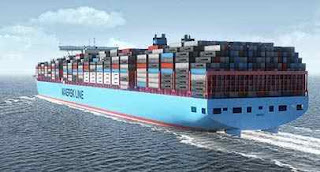|
The Triple-E is a huge ship, designed
specifically to sail from Asia to North Europe, the busiest and longest
route in the world, where economies of scale and fuel efficiency matter the
most. But with a worldwide fleet, (presently there are more than 500 ships
of different types & sizes in
Maersk Line), how does Maersk Line decide which ships to deploy on
which routes? Now Maersk Line is working to manage and rearrange its
shipping network that suits customers and trade requirements.
Keeping the fragile balance between supply
and demand
Maersk Line has planned to deploy 20 new Triple-E ships to carry goods from
Busan of South Korea to Gothenburg in Sweden. This new fleet will ensure
economy of scale, energy efficiency and improved environmental impact.
Transportation of increased number of containers per trip by Triple-E ship
would help the company to save substantial amount of money on account of
fuel and safeguard environmental pollution. Is it a risky action to launch
world’s largest ship in the trade, when global economy is facing recession?
If there is any threat of over tonnage due to depression in seaborne trade,
the carrier can cut capacity elsewhere, in order to adjust the fleet to
grow in line with the market demand.
Managing capacity around the world
Maersk Line operates more than 100 trades, as they are known in the
shipping business, calling at ports in almost every country around the
world. More than 600 vessels sail trades worldwide, around 200 of which are
owned by Maersk Line with the remainder chartered from leasing partners.
The company keeps a close watch on each
trade, managing the network to track which routes are growing and which are
shrinking. Vessel deployment (supply) is adjusted according to the cargo
that needs transporting (demand) – ensuring that Maersk’s service is both
cost effective and environmentally friendly.
Cascading
When Maersk introduces the Triple-E ships on the Asia-Northern Europe loop
(AE10), they will replace other vessels which will then be deployed on
another trade – where they, in turn, will replace other older vessels. This
process is called ‘cascading’.
Sometimes cascading leaves Maersk with
vessels that are surplus to its needs. If these are chartered ships, they
are generally returned to their owners. If they belong to Maersk’s own
fleet, they can be sold or let to other operators, laid up for future use
or recycled if they are not up to current fleet standards.
Ultimately the decision depends on a
ship’s capacity, efficiency, years of service and environmental
performance. In a nutshell, Maersk replaces older vessels with new vessels
of latest technology to maintain a modern fleet, capable enough to meet
customers need.
The Triple-E, however, will be riding the
ocean waves for some time to come – the company expects it to remain in
service for the next 25 to 30 years. News update on other events
The first Triple-E vessel is due in June
2013 and will transport cargo on the highly competitive Asia-Europe route
to cover more than a dozen ports in a loop between Asia and Northern
Europe.
Facts on Triple E ship and market share of
Maersk Line
Maersk Line will take
delivery of the first five (of 20) Triple-E vessels in 2013, deploying them
on the Asia-Europe (AE10) route. The AE10 connects Asia to Northern Europe
via the Suez Canal. The ports on that route currently are : Busan (from April 2013) and Kwangyang
(South Korea); Hong Kong, Ningbo, Shanghai and Yantian (China); Singapore;
Tanjung Pelepas Malaysia); Port Tangiers (Morocco); Rotterdam (the
Netherlands); Bremerhaven (Germany); Gdansk (Poland); Aarhus (Denmark); and
Gothenburg (Sweden)
Maersk has the largest market share of any container shipping
line on the Asia-Europe route, moving 20 per cent of the container cargo
from Asia to Europe and 18 per cent in the opposite direction
The Asia-Europe route is Maersk Line’s busiest. It makes up
one quarter of Maersk Line business and is worth several billion US dollars.
Why is the ship called Triple-E?
The three Es correspond to the ship’s main attributes:
Economy of scale, Energy efficiency and Environmentally improved.
When are you launching the Triple-E?
The first vessel is scheduled to be delivered on 2 July 2013. It will be
launched shortly thereafter. The last one is scheduled for delivery in the
Summer 2015.
What’s the capacity of the Triple-E?
18,000 Twenty-foot Equivalent Units (or containers)
How does that compare to existing ships?
Our largest vessels (Emma Maersk class) have a capacity of 15,500 TEU. With
18,000 TEU, the Triple-E offers a 16% increase.
What are the dimensions of the Triple-E?
The Triple-E is 400 metres long, 59 metres wide and 73 metres high.
How does that compare to existing ships?
That’s three meters longer and three meters wider than the Maersk E-class,
our largest ship.
What is the weight of the Triple-E?
The pure steel weight of the vessel is approximately 55,000 tons. That does
not include ballast water, cargo etc.
How many crew members does it take to
operate a Triple-E?
The Triple-E will be manned by 22 crew.
Are crews specially trained to sail the
Triple-E?
The crew (engineers and navigators) will receive specific training
including five-day simulator training for navigators.
Where will the Triple-E sail?
The Triple-E will sail between Asia and Northern Europe. The list of ports
can be found on www.maerskline.com under Services/AE10
What’s new in the Triple-E?
The main innovations are two ‘ultra-long stroke’ engines, an innovative
efficient shape and advanced waste heat recovery system saving up to 10% of
main engine power.
The Triple-E will have two four-blade
propellers instead of the 6-blade larger propeller found on Maersk E-type
class vessels.
How much fuel does the Triple-E use?
We expect the daily consumption to be approximately 100 tons.
Where will Triple-E go to refuel?
We predominantly fuel the ships in Rotterdam due to the attractive fuel
prices there
What’s the impact of the Triple-E on the
environment?
Shipping is a polluting industry. Maersk Line emits 0.1% of the global CO2
emissions. In 2011 our CO2 emissions amounted to 34 million tons of CO2.
We have invested a lot to improve on those
aspects. The Triple-E will consume approximately 35 percent less fuel per
container than the 13,100 TEU vessels being delivered to other container
shipping lines in these years.
It will be approximately 20% more fuel
efficient than Maersk E-type class vessels, which are currently our best
performing ships.
It will reduce CO2 emissions by more than
50% per container moved, compared to the industry average CO2 performance
on the Asia-Europe trade.
It will come with a ‘Cradle to Cradle
passport’ which is a database describing the material composition of the
main components of the ship. The passport will be kept updated throughout
the lifetime of the ship, and it will enable better recycling of the
materials used to build the ship.
How fast does it sail?
The Triple-E will sail an average speed of 16 knots (=30
km/hour). This means the Triple-Es will be be slow steaming, like
the other vessels on the AE10 string where they will be deployed. The
slower the ship sails, the less fuel it will burn. It is cost and energy efficient
and better for the environment.
How long does it take to sail from Asia to
Europe on a Triple-E?
It takes 24 to 25 days to sail from Shanghai to Rotterdam on the current
trade (AE10).
 |
| "Triple-E"- Largest container ship of the world |
|













